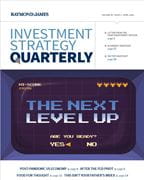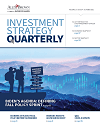Reviewing the building blocks of the global food chain
Declining crop prices are helping to alleviate inflationary pressures, notes Pavel Molchanov, Managing Director, Energy Analyst, Equity Research.
To read the full article, see the Investment Strategy Quarterly publication linked below.
For a typical consumer, the two most hot-button topics are food and energy. Both play a significant role in household spending, and just as importantly, both are highly visible. Gasoline prices are noticed every time a driver fills up at the pump, and food prices are front and center during every visit to a grocery store. Bearing in mind that everyone needs to eat, whereas it is possible to avoid spending on fuel, food tends to outweigh energy in economic importance. In the U.S. Consumer Price Index, for example, food and energy are weighted at approximately 14% and 8%, respectively. While the media likes to write about fast food and cartons of eggs as indicators of food cost inflation, the building blocks of the global food chain are staple crops.
Corn prices: A double-edged sword
To the extent that Americans think about crops, they are most familiar with corn – for one thing, they put it in the gasoline tank. Practically all of the fuel-grade ethanol blended into U.S. gasoline is derived from corn. Corn is also the predominant U.S. source of animal feed. Only 1% of U.S. corn supply is sweet corn, which is what’s sold in the supermarket. The U.S. is the world’s largest corn producer, accounting for nearly one-third of global supply, or as much as second-ranked China and third-ranked Brazil combined. Corn prices fell this past February to their lowest levels since late 2020, around $4/bushel, down from a high of $8/ bushel in mid-2022. U.S. corn plantings in 2023 were up six million acres to a near record 95 million acres – this means more supply in 2024. The U.S. Department of Agriculture forecasts a decline to 91 million acres in 2024, which shows a response to the lower prices.
China is the world’s largest corn importer, followed by Japan – in both countries, corn is important for animal feed. China’s own corn production has plateaued, so all of its incremental demand needs to come from imports. Historically, China had imported almost entirely from the U.S., but that is changing. After the Chinese government approved purchases from Brazil in 2022, imports from the U.S. fell by roughly half.
Russia/Ukraine and the price of wheat
The wheat market has been the most influenced by geopolitics in recent years, because Russia is the world’s third-largest producer, and Ukraine is (or rather was) ranked sixth. When Russia invaded Ukraine in early 2022, wheat prices spiked to an unprecedented $11/bushel. As with corn, prices have dropped by half since then and are currently at three-year lows. Recall, one of Russia’s tactics in the early months of the war had been to impose a blockade of Ukrainian ports, thus halting the export of wheat. In response to intense pressure from African and Middle Eastern countries that depend on this wheat, Russia agreed to allow the resumption of Ukrainian exports in mid-2022. Although one year later this deal fell apart, Ukraine is still exporting via the Black Sea, bearing in mind 1) the weakness of Russia’s navy; and 2) it is difficult to envision the Kremlin making a political decision to attack international civilian ships carrying grain. Ukraine is also shipping some wheat overland into Europe. Although supply from Ukraine is still impacted by the war, there is no longer fear of outright shortages.
The impact of food security measures
The top nine rice-producing countries are all in Asia, led by China and India. Although China produces 20 times more rice than the U.S., it still relies on a significant amount of imports. India, on the other hand, historically had been a rice-exporting country. That changed in 2022, when, in response to concerns about domestic food security, India’s government banned the export of what’s known as broken rice. In 2023, the ban was broadened to encompass plain, white, long-grain rice.
It is an underappreciated fact that sugarcane is the world’s largest staple crop by volume. The sugarcane market is also interesting for the extent to which it is dominated by a single country: Brazil accounts for 40% of the production, even more than the U.S. proportion of the corn market. Much like corn in the U.S., sugarcane plays the central role in Brazilian ethanol supply, and what’s known as sugarcane bagasse – the fibrous, dry part of the plant – is used to generate electricity.
Putting everything together, the U.N. Food and Agriculture Organization’s Food Price Index started 2024 at 118, down 10% from one year ago, and with an even steeper decline versus 2022. Bottom line: good news for consumers. Let’s underscore that food constitutes a larger proportion of spending in lower-income communities compared to wealthier ones, and in emerging markets compared to industrialized economies. Lower food prices open the door to more discretionary spending and, at a macro level, alleviate inflationary pressures and thus support monetary easing by central banks.

Read the full
Investment Strategy Quarterly
All expressions of opinion reflect the judgment of the Chief Investment Office, and are subject to change. This information should not be construed as a recommendation. The foregoing content is subject to change at any time without notice. Content provided herein is for informational purposes only. There is no guarantee that these statements, opinions or forecasts provided herein will prove to be correct. Past performance may not be indicative of future results. Asset allocation and diversification do not guarantee a profit nor protect against loss. The S&P 500 is an unmanaged index of 500 widely held stocks that is generally considered representative of the U.S. stock market. Keep in mind that individuals cannot invest directly in any index, and index performance does not include transaction costs or other fees, which will affect actual investment performance. Individual investor’s results will vary. Investing in small cap stocks generally involves greater risks, and therefore, may not be appropriate for every investor. International investing involves special risks, including currency fluctuations, differing financial accounting standards, and possible political and economic volatility. Investing in emerging markets can be riskier than investing in well-established foreign markets. Investing in the energy sector involves special risks, including the potential adverse effects of state and federal regulation and may not be suitable for all investors. There is an inverse relationship between interest rate movements and fixed income prices. Generally, when interest rates rise, fixed income prices fall and when interest rates fall, fixed income prices rise. If bonds are sold prior to maturity, the proceeds may be more or less than original cost. A credit rating of a security is not a recommendation to buy, sell or hold securities and may be subject to review, revisions, suspension, reduction or withdrawal at any time by the assigning rating agency. Investing in REITs can be subject to declines in the value of real estate. Economic conditions, property taxes, tax laws and interest rates all present potential risks to real estate investments. The companies engaged in business related to a specific sector are subject to fierce competition and their products and services may be subject to rapid obsolescence.


